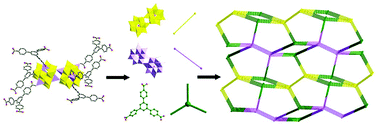The first tritopic bridging ligand 1,3,5-tris(4-carboxyphenyl)-benzene (H3BTB) functionalized porous polyoxometalate-based metal–organic framework (POMOF): from design, synthesis to electrocatalytic properties†
Abstract
Replacing the metal ions (or metal clusters) in routine MOFs with size-matched polyoxoanions to construct POM-based MOF materials (POMOF) combining well-defined crystalline structures, high surface area, regular and tunable cavities is the great challenge in the current POM chemistry area. In this work, we report a 2-fold interpenetrated porous POMOF, [TBA]6[H3PMo12O40]2[Zn8(BTB)2]·(∼35H2O), which exhibits effective catalytic activity towards bromate reduction, using the methodology of extension for the reduced transition-metal-grafted ε-Keggin polyoxoanions with an expanded tripodal bridging ligand of H3BTB. The simultaneous TGA/DSC-MS technique was applied in this work to identify the evolved gases and was proved to be an effective method for analysing the decomposition process.


 Please wait while we load your content...
Please wait while we load your content...